Ikaros (the Latin form of Icarus), newly fitted with wings of feathers and wax by his father Daedulus, flew too close to the sun and plunged into the sea, the sea that now bears his name. Ikaros: the poster child for hubris.
Yet even in Hellenistic times, some writers doubted Daedulus invented wings for the escape from Crete; they believed he invented sails and his poor son Ikaros never winked at Apollo, but merely fell overboard and drowned. It seems the Japanese tilt strongly towards the “sails not wings” hypothesis.
At JAXA—the Japanese Aeospace Exploration Agengy—IKAROS may be an inelegant acronym, but it represents an exciting step in extra-terrestrial propulsion. IKAROS stands for “Interplanetary Kite-craft Accelerated by Radiation of the Sun.” IKAROS is a kite, or a sail, or a “space yacht.” (DS9 fans will likely go for “space yacht.”)
On May 18th Japanese IKAROS leaps skyward from Tanegashima Space Center in southern Japan never—JAXA hopes—to fall to earth again.

(Prefer video to text? Great IKAROS Mission Overview on YouTube—visuals are great but it is in Japanese. Video also at AKATSUKI Special Site.)
A Dream Spaceship
Meet Dr. Osamu Mori, Project Leader, IKAROS’ Solar Power Sail Demonstrator. “Osamu” has several readings in Japanese, among them “leader,” “disciplined,” and “chronicler”; “Mori” means “forest.” Who better to guide interested folk through IKAROS Woods, pointing out ancient trees and unusual fauna?
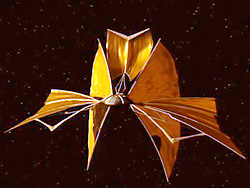
Mori’s dream spaceship soars without engines or fuel. Fitted with a ultra-thin solar-cell sail, IKAROS is propelled by sunlight.
Yuichi Tsuda, a JAXA space systems expert: “Solar sails are the technology that realizes space travel without fuel as long as we have sunlight. The availability of electricity would enable us to navigate farther and more effectively in the solar system.”
Deep Space Deployment
IKAROS represents the first attempt to test solar-sail technology in deep space. Hitherto it has only been tested in Earth orbit.
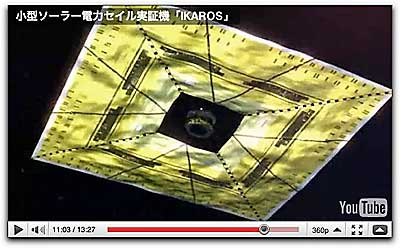
Mission goals:
-
Deploy the large-scale thin sail. Each side of the square sail is about 14 meters. The solar cell film is 7.5 micrometers thick (human hair is 100 micrometers thick).
-
Generate electricity.
-
Test sunlight-powered acceleration.
-
Develop solar-sail navigation technology.
Solar-sail navigation technology, Mori says, means “adjust[ing] the direction of reflected sunlight, so that IKAROS will move along a targeted orbit, and not just travel randomly depending on where the sun happens to be.”
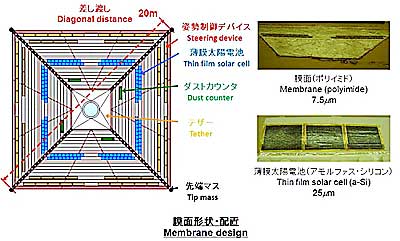
He adds, “IKAROS carries a gas-powered jet engine to change the direction of the sail. It also has a system that will allow it to change direction using only solar power, without using gas. We are going to test both of them.”
IKAROS is a test project. In the future, sails 50-100 meters in diameter will be common.
Headed for the Sun!
IKAROS will be launched with AKATSUKI, JAXA’s Venus Climate Orbiter. For most of the journey from Earth to Venus, IKAROS and AKATSUKI will travel together.
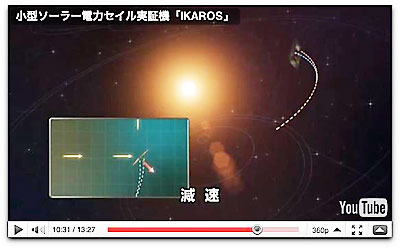
“IKAROS will deploy its sail about a month after launch,” Mori says, “and our first step will be to make sure the thin-film solar cell is generating electricity. For about six months after that, we will be demonstrating the solar sail’s acceleration and orbit-control functions.”

Then the Icarus myth comes full circle. “AKATSUKI will decelerate to enter the Venus orbit, but IKAROS will pass by Venus and navigate around the Sun. Where it heads will depend on how well the solar sail’s orbit control function performs.”
Will IKAROS get too close to the sun? Will IKAROS, instead of falling to Earth fall into the sun? Tsuda promised that “this Ikaros will not fly into the sun.”
Everything You Ever Wanted to Know about Polyimide Resin but Were Afraid to Ask
[Scroll to the next section if polyimide resins leave you cold… ]
In the past, solar-sail technology has been hampered by the inability to create a foil that was not only lightweight, but also able to withstand extreme radiation and heat. The answer? Polyimide resin.
Polyimides are polymers of imide monomers. (For those diving deeper, don’t let Google change “imide” to “amide.”) In a nutshell:
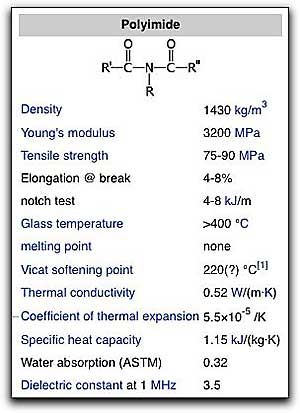
In brief (more here):
The polyimide materials are lightweight, flexible, resistant to heat and chemicals.
Therefore, they are used in the electronics industry for flexible cables, as an insulating film on magnet wire and for medical tubing…
The semiconductor industry uses polyimide as a high-temperature adhesive; it is also used as a mechanical stress buffer…
An additional use of polyimide resin is as an insulating and passivation layer in the manufacture of digital semiconductor and MEMS chips. The polyimide layers have good mechanical elongation and tensile strength… [providing] reliable insulation when subjected to various types of environmental stresses.
Polyimide powder can be used to produce parts and shapes by sintering technologies… Because of their high mechanical stability even at elevated temperatures they are used as bushings, bearings, sockets or constructive parts in demanding applications…
In coal fired power plants, waste incinerators or cement plants, Polyimide fibres are used in hot gas filtration. A Polyimide needle felt separates dust and particulate matter from the exhaust gas.
Not surprisingly, Japan leads the world in polyimide technology and manufacture.
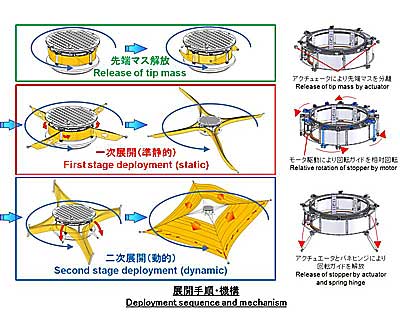
Mori: “Polyimide resin allows us to create a much lighter sail. [It’s] extremely strong, it doesn’t need glue, because it can be joined using heat sealing. Polyimide resin is originally yellow, but one side of IKAROS’s sail is silver. This is because aluminum is vapor deposited on one side of the film, in order to reflect sunlight more efficiently.”
Mori—A Modern Daedulus
While Daedulus may have created a frame for Icarus’ wings—or a mast for his sailboat prototype—Mori points out that IKAROS has no supporting frame.
How does the sail deploy? How does is remain deployed?
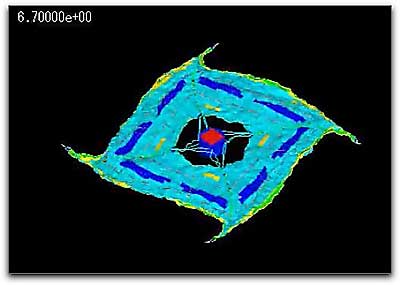
Centrifugal force. (YouTube: Spin Deployment of IKAROS.) The IKAROS team has spent much time working out how to deploy the sail. The process was both time consuming and marked by failures.
Interplanetary Exploration: The Future
JAXA plans to explore the area around Jupiter using a probe with a solar power sail.

Mori says, “The plan is to equip the probe with an ion engine, as well as a solar sail approximately 50 meters in diameter. The larger the sail, the larger the solar-cell area, so the probe will be very efficient, with no need to carry fuel.” He adds, “We are determined to go to Jupiter using solar cells, so we invented a way to generate electricity using the thin-film solar cell on the sail.”
Related Propulsion Post
Around the Solar System in 39 Days (Well, at least to Mars)
Dr. Kirtland C. Peterson—”Cat” to his friends and colleagues—feeds his left brain with science, his right brain with the rich feast of fiction, including SF and fantasy. Among his life’s highlights are sitting in the pilot’s seat of a shuttle prepping for launch at the Kennedy Space Center, and accepting Brannon Braga’s invitation to pitch Star Trek scripts at Paramount in LA. Currently reading William Faulkner’s As I Lay Dying. Just finished Philip Pullman’s The Good Man Jesus and the Scoundrel Christ.










